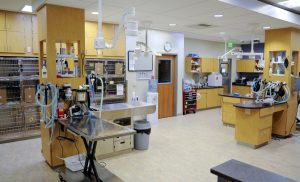ADV-Lesson 2- ICU Equipment and Supplies
Veterinary team members need to be familiar with the “ready area” which is the designated area in your hospital where you triage and treat emergency patients. This area contains all the necessary emergency equipment, supplies, and emergency medications.
It is recommended that your staff practice regular drills based on emergency situations such as cardiopulmonary arrest (CPA) to ensure everyone knows their role and to improve skills and response. This area is also where your crash cart or crash box is located which will be discussed on the next page.
A ready area includes:
- Monitoring equipment such as ECG, ETCO2, BP, SpO2
- IV and/or IO catheter supplies (clippers, aseptic scrub, tape, catheters of various sizes)
- Crash cart/box
- Oxygen supply with masks, humidifier
- +/- oxygen cages with environmental oxygen, CO2, humidity, and temperature monitors
- Suction with suction attachments
- Supplies to collect blood (syringes, blood tubes, etc)
- IV fluids, sets, pumps, pressure bag, etc
- Access to rapid-acting injectable anesthetic agents
- Supplies for centesis (needles or catheters, IV sets, three-way stopcock, syringe, and bowls)
- Bandage materials
- Patient transport and restraint materials (muzzles, blankets, gurney)
- Tools to warm or cool a patient (circulating water blankets, warm air blower, IV fluid warmer, fans, etc)
- Medical Charts
Veterinary Crash Cart
A crash cart or crash box can be as simple as a utility cart on wheels that has multiple draws to store medical equipment and supplies. Sometimes smaller clinics may only have a crash box such as a fishing tackle box or toolbox on the counter. The size of the crash cart/box really depends on the number and types of emergencies your hospital manages. Multiple-doctor, high-volume hospitals typically have larger, more complete crash carts than smaller, low-volume hospitals.
The supplies and equipment in the crash cart can be used for both dogs and cats. Other species can be added such as exotics if your clinic offers services to those species. It’s advisable to keep a drug dose chart either hanging on the wall of your ready area or on the crash cart itself for quick reference. We recommend the RECOVER Emergency Drugs and Dosage Chart that can be downloaded from this link RECOVER Drug Chart
Common Items found in a Crash Cart |
| Laryngoscope |
| Endotracheal tubes (various sizes) |
| Syringes (various sizes) |
| Needles (various sizes) |
| Ambu bag |
| Monitoring equipment (e.g., electrocardiograph, pulse oximeter, capnograph, oscillometric or Doppler blood pressure unit) |
| Intravenous fluids |
| Dextrose 50% |
| Intravenous catheters and the supplies for placing them |
| Emergency drug table & Emergency drugs (e.g., epinephrine, atropine, naloxone, calcium gluconate, furosemide, vasopressin) |

